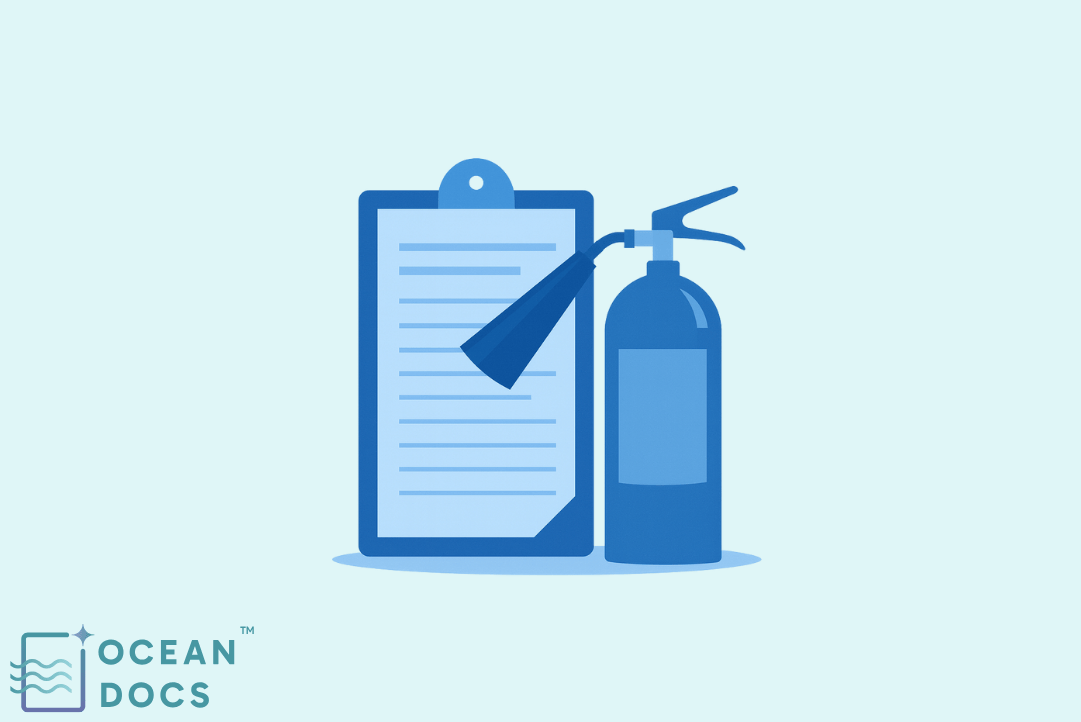
OceanDocs Guide to Fire Control Plan in Shipping Documentation
September 24, 2025 By OceanDocs AI
Fire is one of the most serious emergencies that can occur at sea. With limited escape routes and the presence of flammable materials, even a small incident can quickly threaten lives, cargo, and the vessel itself. This is why every ship is required to maintain a Fire Control Plan as part of its mandatory documentation.
The Fire Control Plan is not just another document in a binder. It is a lifesaving guide, a regulatory requirement, and a critical part of maritime compliance. Understanding what it contains and why it matters is essential for seafarers, safety officers, and inspection teams.
What Is a Fire Control Plan?
A Fire Control Plan is a detailed diagram, or set of diagrams, that shows the location of fire detection and firefighting systems throughout a vessel. It includes:
-
Positions of fire extinguishers, hydrants, and hoses
-
Locations of fixed fire suppression systems
-
Emergency exits and escape routes
-
Fire alarm switches and emergency shut-offs
-
Fire protection zones onboard
The plan must follow IMO and SOLAS regulations and be displayed in accessible areas such as the accommodation block and bridge. A copy is often stored in a watertight container outside the deckhouse so emergency teams can access it during Port State Control inspections or rescue operations.
Why the Fire Control Plan Matters
1. Faster Emergency Response
In a fire, every second counts. The plan helps crew members immediately locate firefighting equipment and follow correct procedures, reducing delays that could worsen the situation.
2. Crew Training
The Fire Control Plan is central to STCW fire safety training. Crews rely on it during drills to practice responses, ensuring that they are prepared for real incidents.
3. Inspection Readiness
Inspection authorities, including Port State Control and vetting auditors, often review the Fire Control Plan. Missing or outdated plans can result in detentions, fines, or a negative risk profile for the vessel.
4. Coordination with External Responders
In an emergency, shore-based responders may need to board the ship. A Fire Control Plan helps them understand the ship’s layout quickly, enabling faster and more effective decision-making.
Regulatory Compliance
Having a Fire Control Plan is not optional. It is required by several global maritime codes:
-
SOLAS mandates that all ships display and maintain fire control plans.
-
ISM Code obliges companies to manage safety risks, including fire hazards.
-
MARPOL is linked because onboard fires can cause pollution, chemical releases, or oil spills. Preventing these risks supports marine environmental compliance.
Together, these regulations ensure that fire preparedness is part of a wider safety and compliance culture.
Moving Beyond Paper Plans
Traditional paper-based shipping documentation is prone to damage, loss, or outdated revisions. During inspections or emergencies, relying on paper alone creates risks.
Digitizing the Fire Control Plan as part of a document intelligence system improves efficiency and reliability. Digital versions can:
-
Be updated instantly when the ship is modified
-
Be stored securely and accessed from multiple points
-
Support inspection readiness by keeping all versions accurate
-
Integrate with other compliance frameworks such as ISPS Code or HSEQ policies
Features of an Effective Fire Control Plan
A Fire Control Plan should:
-
Be updated whenever changes are made to ship layout or equipment
-
Use clear symbols and color coding as required by IMO
-
Be available in the working language of the crew
-
Be displayed in the right locations and accessible digitally
-
Align with company safety systems and integrate with other codes like ISPS and ISGOTT
How OceanDocs AI Supports Fire Control Documentation
OceanDocs AI helps ship operators go beyond paper-based compliance. With OceanDocs, Fire Control Plans and other essential ship records are:
-
Digitized and searchable so they are always inspection-ready
-
Linked with other shipping documents like SOLAS certificates, MARPOL logs, and ISM Code records
-
Easy to update when vessel modifications or new safety measures are added
-
Accessible across crews and shore teams for better collaboration
This approach reduces errors, saves time, and ensures that documentation supports both safety and operational efficiency.
Conclusion
Fires onboard are a real risk, but with preparation they can be controlled. A Fire Control Plan is more than a regulatory checkbox. It is a practical guide that protects lives, supports training, and strengthens inspection readiness.
For companies that want to stay ahead, digitizing the Fire Control Plan is a smart step. OceanDocs AI provides the platform to manage these documents securely, keep them updated, and make them accessible when it matters most.
With OceanDocs, shipping companies are better prepared for audits, safer in operations, and always compliant.